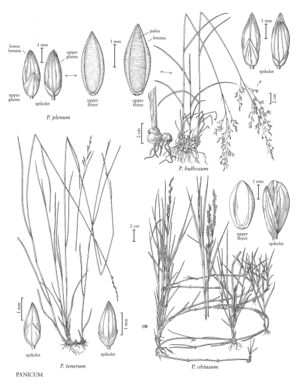Difference between revisions of "Panicum bulbosum"
FNA>Volume Importer |
imported>Volume Importer |
||
| (8 intermediate revisions by 2 users not shown) | |||
| Line 7: | Line 7: | ||
|synonyms={{Treatment/ID/Synonym | |synonyms={{Treatment/ID/Synonym | ||
|name=Panicum bulbosum var. minor | |name=Panicum bulbosum var. minor | ||
| − | |authority= | + | |authority= |
| + | |rank=variety | ||
}} | }} | ||
|hierarchy=Poaceae;Poaceae subfam. Panicoideae;Poaceae tribe Paniceae;Panicum;Panicum subg. Agrostoidea;Panicum sect. Bulbosa;Panicum bulbosum | |hierarchy=Poaceae;Poaceae subfam. Panicoideae;Poaceae tribe Paniceae;Panicum;Panicum subg. Agrostoidea;Panicum sect. Bulbosa;Panicum bulbosum | ||
| Line 20: | Line 21: | ||
-->{{Treatment/Body | -->{{Treatment/Body | ||
|distribution=Ariz.;N.Mex.;Utah;Tex. | |distribution=Ariz.;N.Mex.;Utah;Tex. | ||
| − | |discussion=<p>Panicum bulbosum grows on gravelly river banks and moist mountain slopes, often in ponderosa pine woodlands, from southern Nevada and Arizona to western Texas and central Mexico. It is an important forage grass and is sometimes cut for hay. Flowering is from July to mid-October. Small plants have been called P. bulbosum var. sciaphilum (Rupr. ex E. Fourn.) Hitchc. & Chase or P. bulbosum var. minor Vasey, but size and other characters integrade completely.</p> | + | |discussion=<p><i>Panicum bulbosum</i> grows on gravelly river banks and moist mountain slopes, often in ponderosa pine woodlands, from southern <i>Nevada</i> and Arizona to western Texas and central Mexico. It is an important forage grass and is sometimes cut for hay. Flowering is from July to mid-October. Small plants have been called <i>P. bulbosum</i> var. sciaphilum (Rupr. ex E. Fourn.) Hitchc. & Chase or <i>P. bulbosum</i> <i></i>var.<i> minor</i> Vasey, but size and other characters integrade completely.</p> |
|tables= | |tables= | ||
|references= | |references= | ||
| Line 29: | Line 30: | ||
-->{{#Taxon: | -->{{#Taxon: | ||
name=Panicum bulbosum | name=Panicum bulbosum | ||
| − | |||
|authority=Kunth | |authority=Kunth | ||
|rank=species | |rank=species | ||
| Line 36: | Line 36: | ||
|basionyms= | |basionyms= | ||
|family=Poaceae | |family=Poaceae | ||
| + | |illustrator=Linda A. Vorobik;Cindy Roché | ||
| + | |illustration copyright=Utah State University | ||
|distribution=Ariz.;N.Mex.;Utah;Tex. | |distribution=Ariz.;N.Mex.;Utah;Tex. | ||
|reference=None | |reference=None | ||
| Line 41: | Line 43: | ||
|publication year= | |publication year= | ||
|special status= | |special status= | ||
| − | |source xml=https:// | + | |source xml=https://bitbucket.org/aafc-mbb/fna-data-curation/src/200273ad09963decb8fc72550212de541d86569d/coarse_grained_fna_xml/V25/V25_1286.xml |
|subfamily=Poaceae subfam. Panicoideae | |subfamily=Poaceae subfam. Panicoideae | ||
|tribe=Poaceae tribe Paniceae | |tribe=Poaceae tribe Paniceae | ||
Latest revision as of 18:56, 11 May 2021
Plants perennial; cespitose, rhizomatous, rhizomes short, thin. Culms 50-200 cm tall, 2-3(5) mm thick, with cormlike bases, slightly compressed, erect or geniculate at the lower nodes; nodes glabrous or pilose; internodes slightly compressed, glabrous. Sheaths longer or shorter than the internodes, keeled, glabrous or pilose, hairs papillose-based near the throat; ligules 0.5-2 mm, membranous, dissected ciliate; blades (6)20-65 cm long, 2-15 mm wide, flat, adaxial surfaces glabrous or densely pubescent, particularly basally, occasionally pubescent on both surfaces, hairs papillose-based, bases subcordate to rounded. Panicles 9-50 cm long, 1.5-12 cm wide, open; branches opposite and alternate, straight or flexible, strongly ascending to reflexed; pedicels 0.5-5 mm, scabridulous, divergent. Spikelets 2.8-4.2(5.4) mm long, 1-2 mm wide, ellipsoid or lanceoloid, often purplish, glabrous, acute or obtuse. Lower glumes 1.2-3.5 mm, 1/2 - 4/5 as long as the spikelets, 3-5-veined; upper glumes often longer than the lower lemmas, glabrous, 5-7-veined; lower florets sterile or staminate; lower lemmas glabrous; lower paleas 3-4 mm, sometimes longer than the lower lemmas; upper florets 3-4 mm long, 1-1.5 mm wide, equaling or surpassing the lower lemmas, dull, pale, finely transversely rugose, lemma apices puberulent. 2n = 36, 54, 70, 72.
Distribution
Ariz., N.Mex., Utah, Tex.
Discussion
Panicum bulbosum grows on gravelly river banks and moist mountain slopes, often in ponderosa pine woodlands, from southern Nevada and Arizona to western Texas and central Mexico. It is an important forage grass and is sometimes cut for hay. Flowering is from July to mid-October. Small plants have been called P. bulbosum var. sciaphilum (Rupr. ex E. Fourn.) Hitchc. & Chase or P. bulbosum var. minor Vasey, but size and other characters integrade completely.
Selected References
None.
